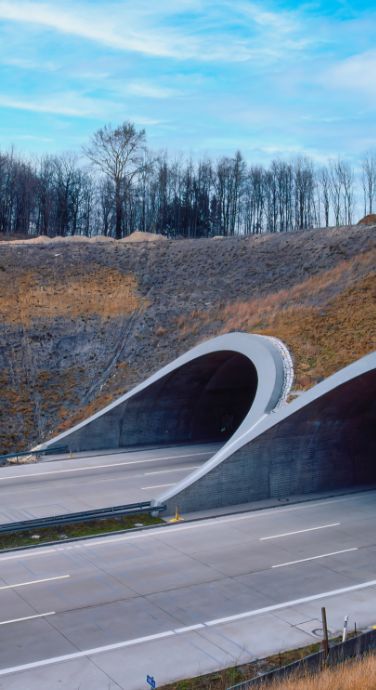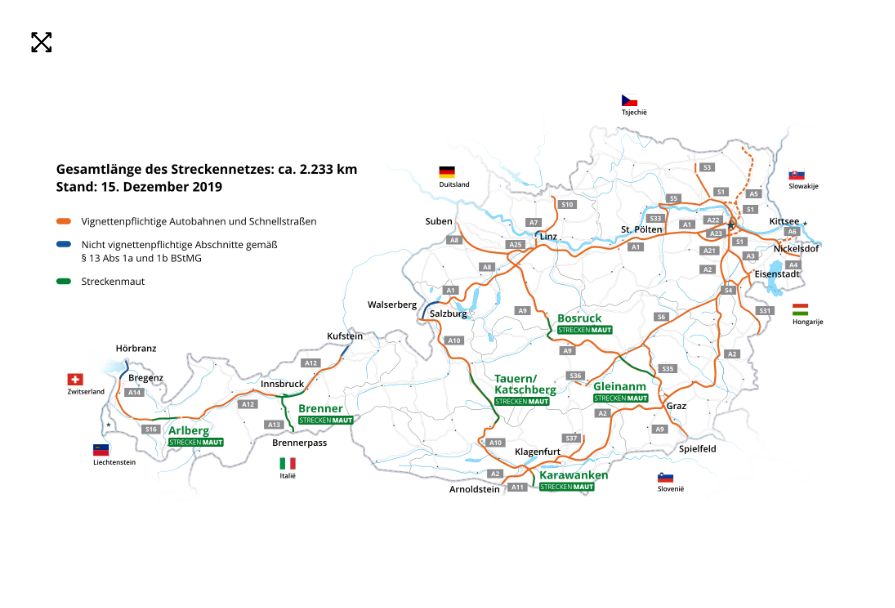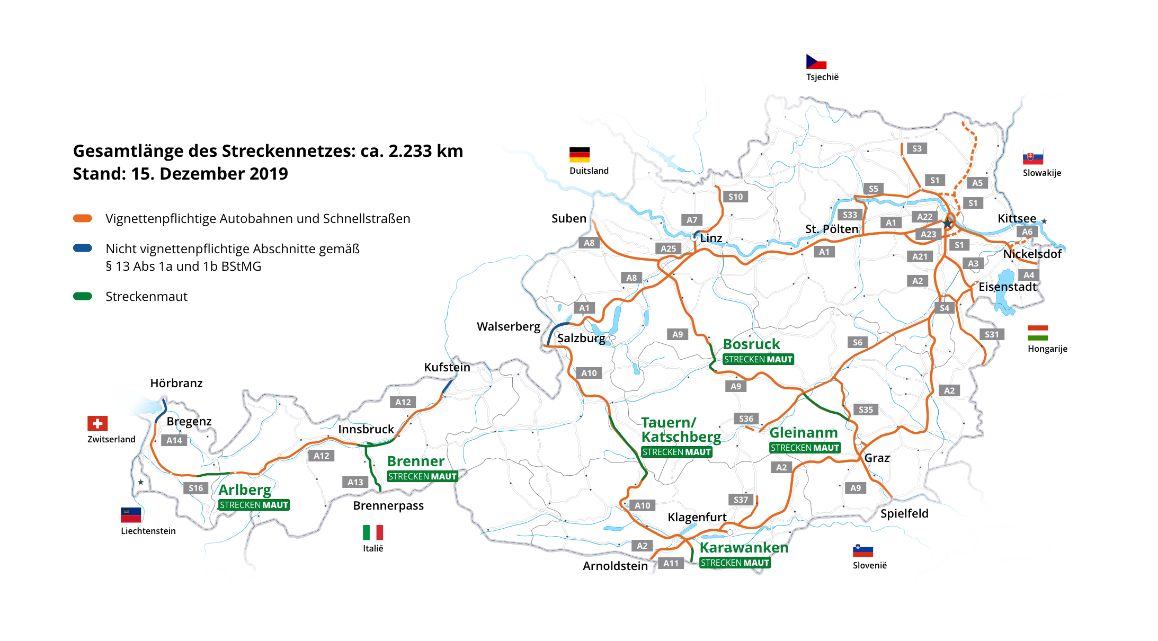Tunnels in Austria
Apart from Italy, Austria has the most tunnels in
Europe. To be exact, 52 tunnels connect different
regions and some even lead to surrounding
countries. You are probably wondering why there are
so many tunnels in Austria.
The answer to that question is quite simple if you look at the topography
of the country. Road tunnels are used to control traffic in mountainous
regions. In the following article, we will present the most important
tunnels, and give you an overview of tunnel fees and tunnel safety. This
information will help you prepare, and you will know exactly which routes
in Austria you have to buy a vignette online for and to whom the tunnel
fees apply.
The most important road
tunnels in Austria
In Austria, both motorway tunnels and ordinary road tunnels exist. The latter are mostly located on state roads and are toll-free. There are also important railroad tunnels, which are equipped with tracks and serve passenger and freight traffic. We will mainly concentrate on the motorway tunnels—after all, they are what most travellers use.
The Arlberg tunnel is almost 14 kilometres long and is therefore the longest in the country. It is not located on one of the motorways, but on the S16 expressway. Nevertheless, it serves an extremely important purpose: the tunnel connects the Austrian states of Vorarlberg and Tyrol. The tunnel basically consists of not one, but two tunnel tubes. That is why it is so long. If you plan on using the road, you must pay a separate toll—but more on that later.
If you look at the well-known Pyhrn Autobahn, you will notice that there are several tunnels along the entire route. One of the most important is probably the Plabutschtunnel, which stands out due to its length of more than 10 kilometres. It is in the western part of the city of Graz.
It is closely followed by the Gleinalmtunnel, which is about 8 kilometres long, and the Bosrucktunnel, which connects Upper Austria with Styria. The Lainberg Tunnel or the Klauser Tunnel are shorter tunnel sections on the Pyhrn Autobahn. The Pfändertunnel connects two important sections on the Rheintal Walgau Autobahn: the Austrian A14 and the German A8. Those planning to drive through the tunnel should allow a little extra time, as there may be delays.
This is because the Pfändertunnel is one of the few motorway sections without tolls. Therefore, no vignette is required for the A14 Rheintalautobahn from the border crossing at Lindau to Hohenems. Accordingly, many drivers choose to travel through that tunnel to reach certain regions of Austria.
Like the Pyhrn Autobahn, there are also several tunnel sections on the A12 Inntal Autobahn. These include, for example, the Roppen Tunnel in the Tyrolean Oberland, which consists not only of one tube but of two in total. Likewise, the Landeck Tunnel on the A12 can be mentioned, which is also often called the “southern bypass”.
Of course, there are several other tunnels in operation, such as those on the A2 Süd Autobahn or S6 Semmering. Due to the many connections, however, a detailed description of each of them would go beyond the scope of this article.

Brenner Basistunnel
Although the network of tunnels in Austria is already well developed, there are still many sections that are being planned or under construction. So far, we have not mentioned the famous Brenner, which is strictly speaking a pass. Although many vacationers already use a section of the route by car, the Brenner Basistunnel, which runs from Innsbruck to Franzensfeste (South Tyrol), will not be fully completed until 2032.
The purpose of this major project is to relieve congestion on the Brenner and Inntal Autobahn. The Basistunnel should soon provide relief to areas with frequent delays and traffic jams. The construction is considered one of the largest projects between Austria, Italy, and the EU.
The Brenner Basistunnel is not the only tunnel planned to open in the future. The Granitzaltunnel and Koralmtunnel are in construction, and the Leitnerbauertunnel and Seekirchnertunnel are still in planning.
Buy Vignette
Tunnel fees in Austria
There is a list of tunnels in Austria that are considered so-called
special toll routes and accordingly require a separate fee. The
reason for the additional fees is that maintenance of the routes
and the measures that apply to tunnel safety are particularly costly.
Therefore, a road toll is charged for travelling through these
tunnels. ASFINAG, the overseeing Austrian infrastructure
company, is the entity that manages most of the road sections and
charges. An additional fee is charged for the following routes:

-
A9 Pyhrn Autobahn
A9 Pyhrn Autobahn: two tunnels, Bosrucktunnel
and Gleinalmtunnel -
A10 Tauern Autobahn
A10 Tauern Autobahn: two tunnels, Tauerntunnel
and Katschberg Tunnel -
A11 Karawankentunnel
A11 Karawanken Autobahn: Karawankentunnel,
St. Jakob (Austria) - Jesenice (Slovenia) -
A13 Brenner Autobahn
A13 Brenner Autobahn (Brenner Basistunnel is
not in operation yet) -
S16 Schnellstraße Arlberg
S16 Arlberg expressway: Arlbergtunnel
You can either pay the tunnel fees in advance online or pay the fees at the toll stations on-site.
The costs differ according to various vehicle types (car, rig, motorcycle, campervan).
The toll is usually valid for a one-way trip, but in some cases, round-trip tickets are also
available. For vehicles exceeding a GVW of 3.5 tons, a different rule applies. Truck drivers
use a GO Box on these routes to calculate the charges.
Travelling safely
through the Alps
Austria is generally known for the good condition of its roads and the associated road safety. The best example is Vienna’s A23 Südost Tangente, which is currently undergoing fundamental renovation through extensive work.
The same applies to the country’s tunnels: since they run through the mountains, they, too, must always be up to date. This requires special safety equipment, and the focus is also placed on “technology and innovation”.
This is illustrated by tunnel monitoring. Several companies specialising in visualisation using state-of-the-art scanners are thus ensuring motorists’ safety. In terms of technology, Austria is even above the international standard.
There are also breakdown bays on the side of the tunnels, fire sensors, and noise protection measures. The emergency services take part in regular tunnel drills so that they are always prepared for emergencies. Of course, motorists are also expected to do their part to ensure their own safety and that of other road users when driving through tunnels.
Rules such as adhering to the speed limit or keeping a sufficient distance with an eye on other road users contribute to everyone’s safety. As a result, you will not only reach your holiday destination safely but also get to enjoy Austria’s impressive tunnels along the way.

